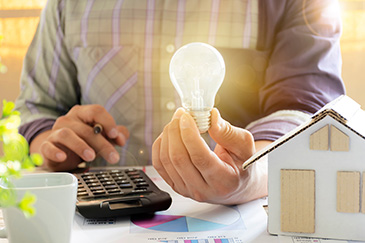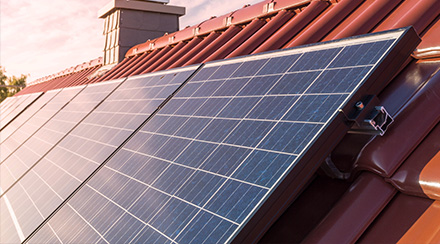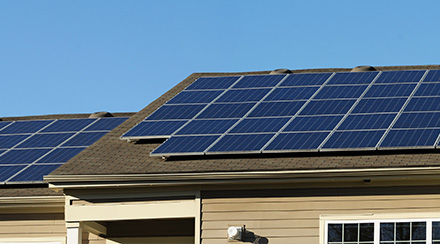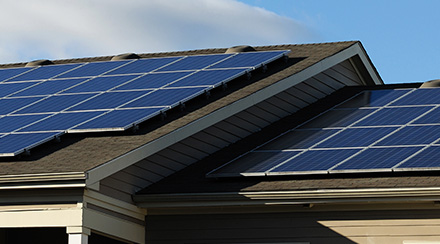How Much Do Solar Panels Cost?

Installing a residential rooftop solar panel system is one of the most impactful ways you can save money while helping the environment. But in order to reap those benefits, you’ll need to make an initial investment – and the size of that investment can vary widely based on a number of factors.
All solar installations are customized based on the size, design and energy needs of the home, so there is no one-size-fits-all price. The cost of solar equipment varies by manufacturer and model, and competition among solar installers adds even more cost variables depending on where you live. Then there are the tax rebates and incentives, which can dramatically reduce the overall price tag.
So where do you begin? Let’s review the basic factors that affect the cost of solar installation, and when you're ready, get personalized savings and instant cost estimates by trying our solar calculator.
How Much Do Solar Panels Cost?
The first cost to consider is the cost of solar equipment. You’ll need solar panels, inverters to convert solar energy into electricity, and mounting hardware to secure the panels to your roof. Your solar installer will order all of this equipment for you, but you may have some options that will affect the overall price.
One option is the type of solar panels you ultimately choose. Most solar panels are classified as monocrystalline, polycrystalline or thin-film. Monocrystalline solar panels are the most energy efficient but also the most expensive. Polycrystalline solar panels are considerably cheaper, but will generate less electricity and may not last as long. Thin-film solar panels come in a few different types, some of which can be as expensive as monocrystalline panels, but they’re rare in residential installations and are primarily used in commercial spaces.
Another option is the number of solar panels you choose to install. Your solar installer can calculate the total number of solar panels that your roof can accommodate, and while it’s often advisable to go with the greatest quantity possible, you can always opt for a smaller system at a lower cost.
Solar installers will typically bundle equipment costs together to put a price on each watt of electricity that a system can produce, and this price per watt will fluctuate based on the number and type of panels that you choose. For example, you might consider a monocrystalline solar panel system that costs $1.50 per watt for the equipment alone. If you substitute polycrystalline panels instead, that price may drop to around $1.00 per watt. If you add more panels, the cost per watt could go down further, but if you subtract panels, the cost per watt may rise. This method of pricing makes it easier to understand the relationship between energy potential and cost, allowing you to fine-tune your system for the best overall value.
How Much Does It Cost to Install Solar Panels?
Installation costs vary quite a bit, and are often greater than the cost of the equipment. Some solar installers may quote their installation rates separately from the equipment cost, but to help their customers budget, it’s common for installers to bundle this expense into the price per watt.
Including installation, most residential solar installations cost somewhere between $2.00 and $3.00 per watt, according to the Center for Sustainable Energy. This means that, before tax incentives and other price breaks, the total cost for a typical 5,000-watt system ranges from about $10,000 to $15,000.
There are several factors that can make solar installation cost more. Larger systems cost more to install than smaller ones, and complex roof designs can also add to the cost. If you live in a sparsely populated area or one where residential solar is uncommon, the lack of competition among solar installers may also make installation more expensive. Even the time of year can affect this cost, as installers may offer price reductions during the slower winter season.
If financing solar panels for your home is important to you, ask your bank or credit union if they offer loans designed for this specific purpose. If they don’t, find out if you qualify for a home improvement loan, home equity loan or home equity line of credit that you can use to purchase solar installation. You can also inquire about terms for personal loans.
Are There Other Costs to Solar Installation?

While the equipment and installation make up the majority of the costs in a typical solar project, you should be prepared for the possibility of other expenses. There are almost always permitting costs, which some solar installers bundle into the per watt price. These rates depend on where you live, but are usually very small in relation to the total system price.
If you live in an older home, your installer may find that your home’s main electrical panel must be upgraded or replaced to accommodate a solar panel system. This can cost anywhere from a few hundred dollars to a few thousand, and may require you to hire an electrician separately from your solar installer.
If your roof is in disrepair or is deemed to be structurally insufficient to support an array of solar panels, you may also need to invest in repairs or reinforcements before your solar installation can begin.
Are There Tax Incentives for Solar Installation?
Now that we’ve analyzed the costs, there is some good news – you may qualify for tax incentives and other programs to help cover some of the cost of solar installation.
There is a federal solar tax credit that allows you to deduct a percentage of your solar installation cost from your federal income tax liability. The duration and size of this tax credit is determined by congress, which may continue to renew it or may eventually allow it to expire. You should check the Department of Energy website for the current terms and for news about the future of the program.
Depending on where you live, there may also be state or local programs that incentivize solar installation. These can take the form of tax credits, cash rebates, free or reduced permitting fees, property tax exemptions and more. Additionally, your electrical utility and/or electricity provider may have their own solar incentive programs.
You can do your own research by checking the official websites of your state, city, utility and electricity provider, but solar installers are also great sources for this information. If you reach out for a solar installation quote, be sure to ask for help identifying which incentives you may qualify for.
How Much Do Solar Panels Save on Electricity?
We can’t discuss the cost of solar installation without mentioning the energy savings. Depending on how much solar energy your home generates versus how much you consume, you could even earn money with your solar installation by selling excess electricity to your local utility. But at the very least, you should expect a significant reduction in your monthly electricity bills.
Our solar calculator gives you personalized savings and instant cost estimates, or you can ask a solar installer to calculate this for you as part of your price quote. This data will tell you approximately how long it will take for your solar installation to pay for itself, which is often less than ten years. After that, you’re generating pure savings.
A solar installation is also a huge investment in your home equity, and can be a significant selling point if you ever decide to sell your home. Homes with solar installations sold for 4.1 percent more on average than similar homes without solar panels, according to a 2019 study by Zillow.
Residential rooftop solar installations are high-involvement purchases, and calculating the total upfront cost can be complicated. But if you’re considering an investment in your home and our planet, it’s well worth crunching the numbers with the help of a dependable solar installer.
Looking for Something Specific?
Select a category to find resources for topics that interest you.
Select Category

Related Articles:

What Is Solar Energy and How Does it Work?
Thanks to rapidly advancing technology, a growing share of our energy comes from renewable sources like wind, hydropower and solar. Learn about solar energy and how it provides for homes and communities.
Read Article
How Do Solar Panels Work?
Rooftop solar panels are among the most visible symbols of a new energy future that is cleaner, healthier and more renewable. But do you know how solar panels work?
Read Article
The Different Types of Solar Panels
When deciding what type of solar panel is best for your home, it’s worth taking the time to weigh the pros and cons of each panel type against your budget, climate and energy needs.
Read ArticleHow Much Do Solar Panels Cost?
Installing a residential rooftop solar panel system is one of the most impactful ways you can save money while helping the environment. But in order to reap those benefits, you’ll need to make an initial investment – and the size of that investment can vary widely based on a number of factors.
All solar installations are customized based on the size, design and energy needs of the home, so there is no one-size-fits-all price. The cost of solar equipment varies by manufacturer and model, and competition among solar installers adds even more cost variables depending on where you live. Then there are the tax rebates and incentives, which can dramatically reduce the overall price tag.
So where do you begin? Let’s review the basic factors that affect the cost of solar installation, and when you're ready, get personalized savings and instant cost estimates by trying our solar calculator.
How Much Do Solar Panels Cost?
The first cost to consider is the cost of solar equipment. You’ll need solar panels, inverters to convert solar energy into electricity, and mounting hardware to secure the panels to your roof. Your solar installer will order all of this equipment for you, but you may have some options that will affect the overall price.
One option is the type of solar panels you ultimately choose. Most solar panels are classified as monocrystalline, polycrystalline or thin-film. Monocrystalline solar panels are the most energy efficient but also the most expensive. Polycrystalline solar panels are considerably cheaper, but will generate less electricity and may not last as long. Thin-film solar panels come in a few different types, some of which can be as expensive as monocrystalline panels, but they’re rare in residential installations and are primarily used in commercial spaces.
Another option is the number of solar panels you choose to install. Your solar installer can calculate the total number of solar panels that your roof can accommodate, and while it’s often advisable to go with the greatest quantity possible, you can always opt for a smaller system at a lower cost.
Solar installers will typically bundle equipment costs together to put a price on each watt of electricity that a system can produce, and this price per watt will fluctuate based on the number and type of panels that you choose. For example, you might consider a monocrystalline solar panel system that costs $1.50 per watt for the equipment alone. If you substitute polycrystalline panels instead, that price may drop to around $1.00 per watt. If you add more panels, the cost per watt could go down further, but if you subtract panels, the cost per watt may rise. This method of pricing makes it easier to understand the relationship between energy potential and cost, allowing you to fine-tune your system for the best overall value.
How Much Does It Cost to Install Solar Panels?
Installation costs vary quite a bit, and are often greater than the cost of the equipment. Some solar installers may quote their installation rates separately from the equipment cost, but to help their customers budget, it’s common for installers to bundle this expense into the price per watt.
Including installation, most residential solar installations cost somewhere between $2.00 and $3.00 per watt, according to the Center for Sustainable Energy. This means that, before tax incentives and other price breaks, the total cost for a typical 5,000-watt system ranges from about $10,000 to $15,000.
There are several factors that can make solar installation cost more. Larger systems cost more to install than smaller ones, and complex roof designs can also add to the cost. If you live in a sparsely populated area or one where residential solar is uncommon, the lack of competition among solar installers may also make installation more expensive. Even the time of year can affect this cost, as installers may offer price reductions during the slower winter season.
If financing solar panels for your home is important to you, ask your bank or credit union if they offer loans designed for this specific purpose. If they don’t, find out if you qualify for a home improvement loan, home equity loan or home equity line of credit that you can use to purchase solar installation. You can also inquire about terms for personal loans.
Are There Other Costs to Solar Installation?
While the equipment and installation make up the majority of the costs in a typical solar project, you should be prepared for the possibility of other expenses. There are almost always permitting costs, which some solar installers bundle into the per watt price. These rates depend on where you live, but are usually very small in relation to the total system price.
If you live in an older home, your installer may find that your home’s main electrical panel must be upgraded or replaced to accommodate a solar panel system. This can cost anywhere from a few hundred dollars to a few thousand, and may require you to hire an electrician separately from your solar installer.
If your roof is in disrepair or is deemed to be structurally insufficient to support an array of solar panels, you may also need to invest in repairs or reinforcements before your solar installation can begin.
Are There Tax Incentives for Solar Installation?
Now that we’ve analyzed the costs, there is some good news – you may qualify for tax incentives and other programs to help cover some of the cost of solar installation.
There is a federal solar tax credit that allows you to deduct a percentage of your solar installation cost from your federal income tax liability. The duration and size of this tax credit is determined by congress, which may continue to renew it or may eventually allow it to expire. You should check the Department of Energy website for the current terms and for news about the future of the program.
Depending on where you live, there may also be state or local programs that incentivize solar installation. These can take the form of tax credits, cash rebates, free or reduced permitting fees, property tax exemptions and more. Additionally, your electrical utility and/or electricity provider may have their own solar incentive programs.
You can do your own research by checking the official websites of your state, city, utility and electricity provider, but solar installers are also great sources for this information. If you reach out for a solar installation quote, be sure to ask for help identifying which incentives you may qualify for.
How Much Do Solar Panels Save on Electricity?
We can’t discuss the cost of solar installation without mentioning the energy savings. Depending on how much solar energy your home generates versus how much you consume, you could even earn money with your solar installation by selling excess electricity to your local utility. But at the very least, you should expect a significant reduction in your monthly electricity bills.
Our solar calculator gives you personalized savings and instant cost estimates, or you can ask a solar installer to calculate this for you as part of your price quote. This data will tell you approximately how long it will take for your solar installation to pay for itself, which is often less than ten years. After that, you’re generating pure savings.
A solar installation is also a huge investment in your home equity, and can be a significant selling point if you ever decide to sell your home. Homes with solar installations sold for 4.1 percent more on average than similar homes without solar panels, according to a 2019 study by Zillow.
Residential rooftop solar installations are high-involvement purchases, and calculating the total upfront cost can be complicated. But if you’re considering an investment in your home and our planet, it’s well worth crunching the numbers with the help of a dependable solar installer.
Looking for Something Specific?
Select a category to find resources for topics that interest you.
Select Category

Related Articles:

What Is Solar Energy and How Does it Work?
Thanks to rapidly advancing technology, a growing share of our energy comes from renewable sources like wind, hydropower and solar. Learn about solar energy and how it provides for homes and communities.
Read Article
How Do Solar Panels Work?
Rooftop solar panels are among the most visible symbols of a new energy future that is cleaner, healthier and more renewable. But do you know how solar panels work?
Read Article
The Different Types of Solar Panels
When deciding what type of solar panel is best for your home, it’s worth taking the time to weigh the pros and cons of each panel type against your budget, climate and energy needs.
Read Article






